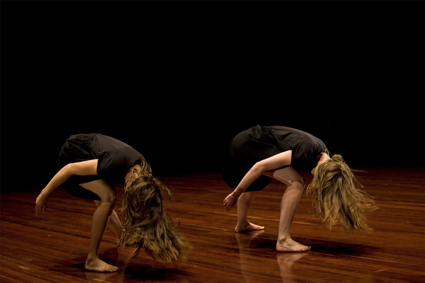suggestive formalism
jana perkovic: natalie abbott, physical fractals

Natalie Abbott, Sarah Aitken, Physical Fractals
photo Ponch Hawkes
Natalie Abbott, Sarah Aitken, Physical Fractals
EVER SINCE MODERN DANCE BUILT ITS MANIFESTO ON THE REJECTION OF REALISTIC STORYTELLING, CONTEMPORARY DANCE HAS BEEN A BIT OF A HARD SLOG FOR UNACCUSTOMED AUDIENCES. A DEEPLY ABSTRACT ART—AND NATALIE ABBOTT’S PHYSICAL FRACTALS IS RIGHT UP THERE WITH THE MOST ABSTRACT—CONTEMPORARY DANCE OFTEN HINGES ON A CAPACITY FOR SUGGESTIVENESS AND THE DESIRE TO CULTIVATE A RICH INTERIOR LIFE.
The tenuous ‘truth’ of a dance work is so often buried somewhere between movement and mood, that we all, I would say, need the ability to let our minds wander over the physical performance, if we are to get to its core.
Postmodernism has brought narrative, realism and politics back into dance, but not evenly so. In particular, there is a strand of Australian dance that has furiously resisted all figuration, remained staunchly formalist and—I mean this without reprimand—has privileged mood and atmosphere over concept and narrative. Physical Fractals, the first long-form work by young choreographer Natalie Abbott, sits squarely within this tradition. The work examines how a cross-interference of media stimuli—sound, light and movement—can create a meaningful audience experience. It is deeply formalist in intent, and I am somewhat glad I entered the auditorium without knowing this.
Two young female dancers, Abbott herself and Sarah Aitken, dressed in loose, comfortable black, perform repetitious sequences of simple gestures, gradually drawing intersecting lines within the circular stage. Their movements are uncomplicated but heavy, Haka-like—wide stomping backwards, dangling arms, weighted jumping, running, heavy falling of bodies—with strong, pendular shifts of weight. The choreography emphasises the weightiness of these two (quite lithe) bodies, and creates an effect of empathetic physical exhaustion in the audience, particularly as we watch Abbott and Aitken repeatedly crash to the ground, in the final sequence. Meanwhile, their thumps and stomps are looped, magnified and sent swirling back, building into a powerful echo, as if the two women are single-handedly raising a storm. At one point, the dancers swing microphones on their cords, building a symphony of static. The effect is hypnotic but deep: the heaviness of the performance lodges itself deeply in one’s body.

Sarah Aitken, Natalie Abbott, Physical Fractals
photo Ponch Hawkes
Sarah Aitken, Natalie Abbott, Physical Fractals
At its best, Physical Fractals makes us feel the sheer force of these simple movements on the dancers’ bodies. Abbott seems to emphasise weight not purely for sonic effect: repetition of falling, faltering and stooping builds a narrative of physical strain and resilience. It could be easily read as a feminist choreography, but equally as a humanist one (female body has limited significance here). Its dancing bodies are grounded, weighted, imperfectly synced, injurable, far from the superhero flying automata that one still sees. I was reminded acutely of Anne Teresa de Keersmaeker’s early work, particularly Rosas Dans Rosas and Bartók, which wove the same strands of repetition, simple gestures and femininity into something formalist, yet humbly political and life affirming. (There was also an echo of her later work, which explores darkness, movement and silence within similar parameters.) But I kept waiting in vain for this work to use its magnificently realised means in the pursuit of some higher goal.
Physical Fractals continuously operated on the same plane, neither submerging us under its powerful storm into a meditative enlightenment, nor raising us to a bird’s eye realisation of higher purpose. I could not detect a fractal pattern (a fractal is self-similar, presenting the same complexity of build at different scales: think cauliflower or snowflake). I was waiting for a minimum of philosophical framework, something to gently give meaning to the genuine empathy the work was creating, something between awe and care; I was waiting for Abbott to utilise the powerful spell she had cast on us. It never came, and the work is weaker for its unfulfilled potential than it would have been had it ventured a smaller stake.
For the pure affective stamp it leaves, Physical Fractals is a formally successful work, and Abbott a sensitive and intelligent choreographer. Just as de Keersmaeker’s formalist work created political resonances she had not necessarily had in mind, so was I able to enjoy an interior dialogue about strength, resilience, mysticism and the fourth wave of feminism while hypnotised by this fine choreography. This is not, and cannot be wrong: the figurative emptiness at the heart of contemporary dance requires a suggestible viewer. I cannot escape the impression, however, that I enjoyed Physical Fractals for the wrong and unexpected reasons—against the grain of the author’s intent.
Dance Massive: Physical Fractals, choreographer, director, performer Natalie Abbott, collaborator Rebecca Jensen, performer Sarah Aitken, live sound design Daniel Arnot, dramaturg Matthew Day, lighting Govin Ruben; Arts House, North Melbourne Town Hall, March 12-16; http://dancemassive.com.au/
RealTime issue #114 April-May 2013 pg. 31






